Samsung Epic 4G Review: The Fastest Android Phone
by Anand Lal Shimpi on September 6, 2010 5:28 PM EST- Posted in
- Smartphones
- Samsung
- Epic 4G
- Gadgets
- Mobile
The Fastest GPU in a Smartphone
One thing I’ve learned over the past several years is that if you’re not the original manufacturer of something and are simply a glorified parts assembler, you generally have no clue how to do something right. There are obvious exceptions (Apple appears to be doing well), but this characterization applies to a lot of companies in the consumer electronics industry. They buy chips and parts from various suppliers, do a little bit of industrial design and generally don’t have the engineering know-how to deliver an optimized product into the marketplace.
Samsung is quite the opposite. Samsung is a DRAM manufacturer, a NAND flash manufacturer, and an application processor manufacturer. Samsung is responsible for the DRAM, NAND and silicon that goes into every iOS device sold by Apple. The company knows a thing or two about engineering.
The SoC inside the Epic 4G and other Galaxy S parts is called Hummingbird. It’s a 45nm SoC that implements a standard ARM Cortex A8 running at 1GHz and a PowerVR SGX 540 GPU. Despite Samsung’s experience in silicon manufacturing, it’s not much of an architecture/design company so we do see a lot of IP licensing within Hummingbird.
In this capacity Samsung is no different than TI, but what really sets Hummingbird apart is its GPU. Licensed from Imagination Technologies, the PowerVR SGX 540 is a significant improvement over the 530/535 in use in the iPhone, iPad and Motorola’s Droid X.
The SGX 530 has two USSE pipes and a single texturing unit. The 535 adds a second texturing unit, and the 540 adds another two USSE pipes. It’s unclear what clock speed the SGX 540 runs at inside Hummingbird, but I’d expect it’s somewhere near the 200MHz of the 535 in TI’s OMAP 3630.
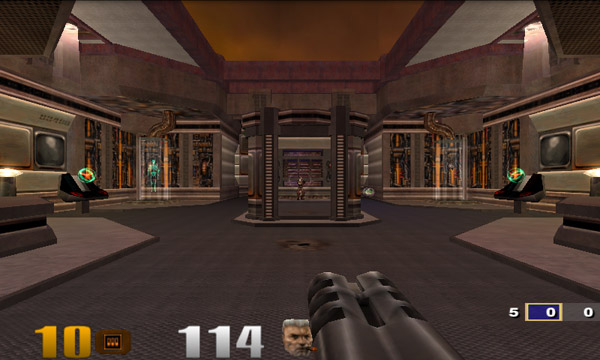
Quake 3 Arena running on the PowerVR SGX 540
The added execution hardware does incur a power penalty, however Imagination lists it as less than double the SGX 535.
The performance improvement is tangible. Samsung’s Hummingbird faster in 3D games/apps than any other SoC used in a smartphone today:
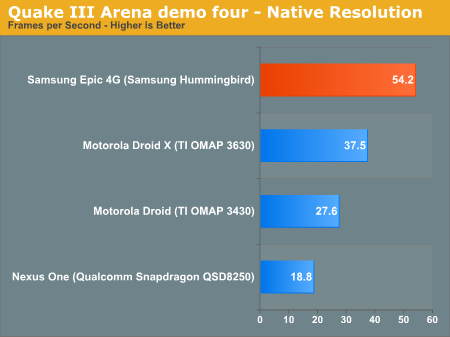
Under Quake III we saw a 44.5% increase in performance over the Droid X. Compared to Qualcomm's Snapdragon, performance improves by nearly 2x.
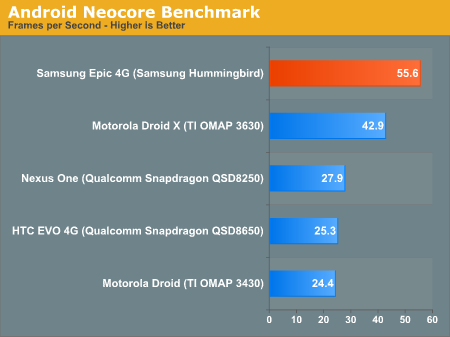
Even in Qualcomm's own 3D test, the PowerVR SGX 540 is more than twice as fast as the Snapdragon. We see a 30% performance advantage over the OMAP 3630. I'd expect to see about the same advantage over Apple's A4.
Unfortunately for Samsung, 3D gaming hasn’t really taken off on Android as a platform. The best examples of what’s to come are what we’ve seen from Epic and id, but both of those demos were done on iOS (although I suspect Android versions would hit at some point) and we’re still pretty far away from having actual games based on those engines on mobile phones.
While the SGX 540 could be responsible for the Epic 4G’s smoother than expected UI, it’s mostly a waste of hardware today. Clearly you don’t need this powerful of a GPU to make scrolling through menus smooth. Perhaps Samsung has grand plans for Hummingbird or simply wanted to outdo the competition on paper. Higher resolution products due out in the future will demand faster GPUs (think tablets) so it’s possible that Hummingbird wasn’t specifically targeted for an 800 x 480 smartphone.
General CPU performance is comparable to the OMAP 3630 and what you’d expect from a 1GHz Cortex A8. The 45nm SoC should sip power but it’s unclear what Samsung is doing for power management on the SoC itself. While both Hummingbird and Apple’s A4 are manufactured at the same fab at 45nm and both use the Cortex A8, there’s a lot more to determine the total power consumption of an SoC.

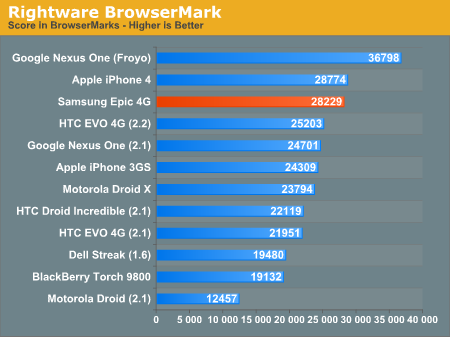
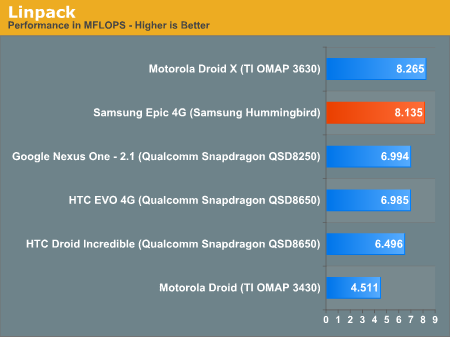
Hummingbird’s memory bus is likely a 32-bit single channel LPDDR1 interface, but overall I’d say it’s safe to say that this is the fastest SoC currently shipping in a smartphone. Apple’s A4 used in the iPhone doesn’t run at 1GHz, and TI’s OMAP3630 uses the PowerVR SGX 530 compared to Samsung’s SGX 540. Unfortunately much of the performance advantage will go unused as 3D gaming simply isn’t that prevalent on Android phones today.










93 Comments
View All Comments
Alexo - Thursday, September 9, 2010 - link
I agree with gvally, this discrepancy between the results should be explained.jasperjones - Monday, September 6, 2010 - link
Ultimately if you’re trying to give someone a more iOS-like experience on an Android phone, Samsung gets the job done.more iOS-like experience? do not want
dvinnen - Tuesday, September 7, 2010 - link
Luckly because it is Android and you can do what you like with it there are home screen replacements on the market. I use the open source ADW replacement and got rid of the iOS knock off crapspathotan - Monday, September 6, 2010 - link
TouchWiz is the sole reason im avoiding these phones. HTC still has the best UI and their devices run good without having to root and use bootloaders.The device is a total failure if you have to root it and use hacks/bootloaders to get it to perform "good".
StealthX32 - Monday, September 6, 2010 - link
Hey, at least it's easy to root... ;)It's 2 steps versus 30 or so that you need to on the EVO 4G.
That said, I do agree with you; the product should be judged as released.
Dane74 - Monday, September 6, 2010 - link
Sprint has excellent warranty. they handle it in store themselves for warrantable problems for free for one year even if you purchase NO protection plan. So rooting it, which voids warranty if detected, carreis some risk of a lost substantial benefit.sprockkets - Monday, September 6, 2010 - link
That's the problem with Samsung. Motorola's CEO (or someone high up) called them Samesung. They are like the KIA of smartphones, copying Honda.That being said, I might check up on the Vibrant. Then again, a more vanilla G2 is just around the corner.
afkrotch - Monday, September 6, 2010 - link
Actually, phones like these have been out a while now. Just not in the US. The Galaxy S looks the same most of the other Samsung phones that have been on the Korean market for the past 1-2 years.I would have much preferred the Samsung Haptic Pop, than the Galaxy S. Sadly, we'll never see the Haptic Pop in the states. I have the T-Mobile Galaxy S. It feels too much like an iPhone. Only thing I like, the AMOLED screen.
bearxor - Monday, September 6, 2010 - link
Sure you haven't been watching too much 30 Rock? In the beginning of Season 3, Will Arnett's character claims that he 'sold the E (in GE) to Samsung. They're Samesung now."That's the only place I've heard anything like that.
bigboxes - Monday, September 6, 2010 - link
As a Palm Pre user I know the pain of poor battery life. I thought the Super AMOLED display was suppose to improve batter life by almost double over the EVO. What happened? As far as the Pre goes I have mine o/c to 800Mhz and it's very snappy. Add the almost cooperative nature of Palm to the homebrew community means that I can customize my phone to make up for the OS shortcomings. The GPS on the Pre is craptastic as well. Hopefully, Palm will improve on these when they release new models this fall.